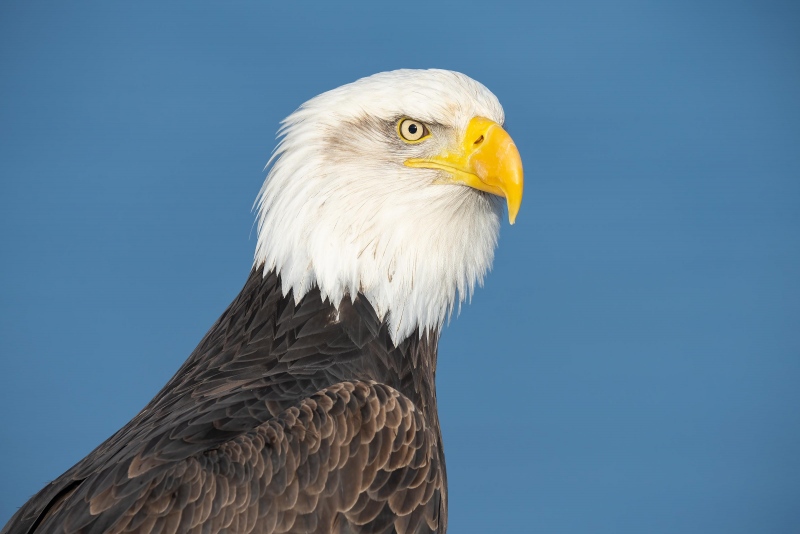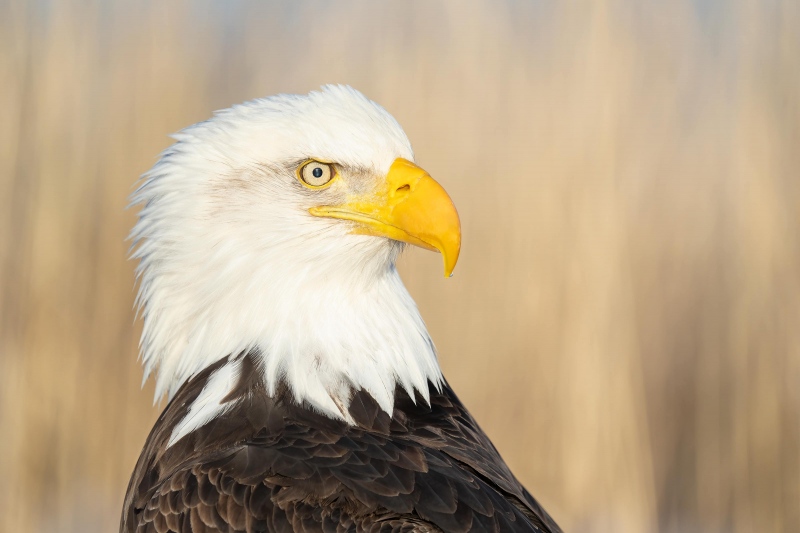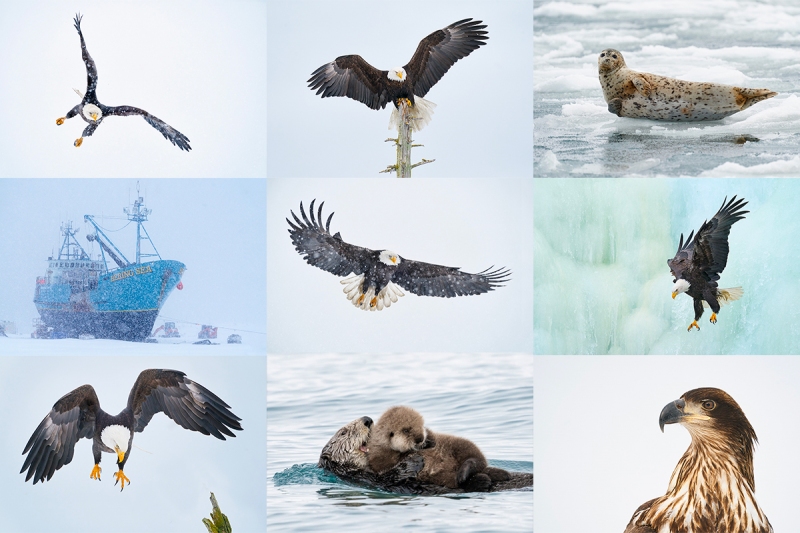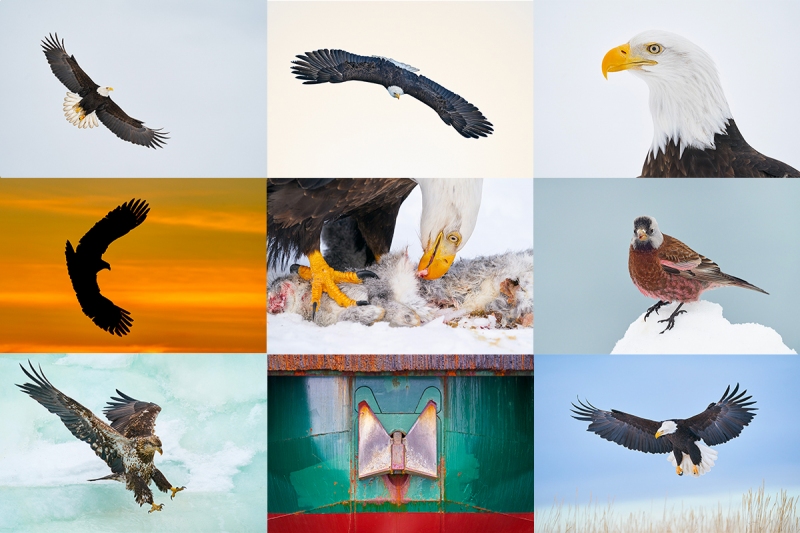Your Fave?
Which is the stronger of today’s two featured images? All are invited to leave a comment and explain why they made their choice. If you would like to create images like this, do consider joining me in Homer in early 2023.
What’s Up?
Conditions for photography were pretty good on Friday morning but I was less than inspired and did not do much … That evening was another busted sunset. I just got back from a pretty successful ride-around the lakeshore. With a brisk southwest wind and cloudy-very-bright conditions, I worked the crane family at eye level from the edge of the canal with the hand held Sony FE 70-200mm f/2.8 GM OSS II lens, the 2X TC and the a1. I am pretty sure that I got some decent stuff.
Today is Saturday 12 March 2022. Wherever you are and whatever you are doing, I hope that you too had a great day. This blog post took about 90 minutes to prepare and makes three days in a row with a new one.
Please remember to use the B&H and Amazon links on most blog pages and to use the BIRDSASART discount code at checkout when purchasing your new gear from Bedfords. And please consider joining a BAA IPT. You will be amazed at how much you will learn …
|
|
|
This image was created on 26 February 2022, day one of the second 2022 Homer/Kachemak Bay IPT. I used the hand held Sony FE 200-600mm f/5.6-6.3 G OSS lens (at 600mm), and The One, the Sony Alpha 1 Mirrorless digital camera. ) The exposure was determined using Zebra technology with ISO on the Thumb Dial. ISO 640: 1/1000 second at f/10 (stopped down 1 1/3 stops). AWB at 10:05:49am on a sunny morning. Tracking: Spot S with Bird/Face-Eye Detection performed perfectly. Be sure to click on the image to enjoy a high-res version. Image #1: Bald Eagle head portrait with distant blue water background
|
Pure BIRDS AS ART
Image #1 is created in the pure BIRDS AS ART style: clean, tight, and graphic, with a soft, soft, dreamy background. Note that though I stopped down 1 1/3 stops for a bit of extra depth of field on the subject, the background is completely de-focused, i.e., smooth and creamy. Why? See #3 below.
Background Softness (Bokeh?) Simplified
The simplification of my thoughts on the principles that determine the quality of out-of-focus backgrounds in a photograph — bokeh, by some definitions — came to me early this morning while I was in a dream-like state sometime between 3:30 and 5:30am. Note: I slept 10 hours!
- 1-To produce soft, buttery backgrounds, telephoto lenses are better than wide angle lenses because they effectively place you “closer” to the subject and offer narrower angles of view.
- 2-The closer you are to the subject, the more the background detail is reduced.
- 3-The greater the distance from the subject to the background, the more the background detail is reduced.
- 4-With everything above being equal, the wider the aperture, the softer the background detail. Note that #2 & #3 supersede #4. For example, if you are working relatively close to a subject with a telephoto lens at f/16, and the background is literally one-half mile away — a distant forest, for example, the background will be soft and creamy despite the small aperture. Conversely, if a bird is perched on a leafy branch, the leaves will be well-defined even if you are working at f/2.8.
- 5-When you are close to a subject with a telephoto lens and the distance-to-the-subject is not too great, say in the range of ten to twenty feet, stopping down will often bring up unwanted background detail.
|
|
|
This image was created on 19 February 2022, the scouting day for the 2022 Homer/Kachemak Bay IPTs. I used the hand held Sony FE 200-600mm f/5.6-6.3 G OSS lens (at 600mm), and The One, the Sony Alpha 1 Mirrorless digital camera. ) The exposure was determined using Zebra technology with ISO on the Thumb Dial. ISO 800: 1/2000 second at f/6.3 (wide open). AWB at 9:51:06am on a sunny morning. Tracking: Spot S with Bird/Face-Eye Detection performed perfectly. Be sure to click on the image to enjoy a high-res version. Image #2: Bald Eagle head portrait with background grasses
|
A Big Sony 200-600 Misconception
Many folks assume that the Sony 200-600 f/6.3 G lens (and the Canon RF 100-500 f/7.1 lens as well), are not capable of producing soft, smooth, dreamy, creamy, defocused backgrounds as they are relatively “slow” at f/6.3 and f/7.1 respectively. As you can see in image #2, this is a big misconception. Why? As stated in #2 above, the closer you are to the subject, the more the background detail is reduced. The trick here was to get ACAP (as close as possible) to the subject and to work at the wide open aperture, in this case, f/6.3. The result: the potentially distracting yellow grasses were rendered almost completely out of focus. Note: I was about eight feet from the bird, and the grasses were about eight feet beyond the eagle.
On Bokeh
There are almost as many different definitions of bokeh (as it pertains to photography) as there are pronunciations. This one, from Wikipedia, works well for me:
Bokeh (from the Japanese: [boke]), is the aesthetic quality of the blur produced in out-of-focus parts of an image.
Some tighter definitions, like the one below from Adobe, do not work for me (in this instance), as they refer only to the qualities of out-of-focus points of light (AKA specular highlights).
Bokeh is a word with Japanese origins, defined as “the way the lens renders out-of-focus points of light.”
How to Pronounce Bokeh
This short (2:48) video is a bit humorous. You can skip the funny stuff and get to the “right answer” at the 1:37 mark, but be sure to watch to the end for the very fine points.
From BPN-friend Kevin Hice via unsolicited e-mail
Again artie, that was a great trip. I was more than pleased. For me, I could see right away that you knew how to get us and the boat in great position for the best eagle photography. You took into consideration all the factors including the sky conditions, and wind and sun angles. It was a real pleasure to meet the captain. His knowledge of the wind and the currents helped to put us in great position all the time and he did his very best to help on all fronts.
One of the most important factors for me is timeliness. We never had to wait on the captain or on you, artie, and that made the trip a huge success. We got after it every day and had countless great photography opportunities. The other eagle photography tours never got out as early as we did, nor did they pursue the birds as relentlessly as we did.
One can never say that Arthur Morris doesn’t have the passion to get after the Bald Eagles. I have never shot as many photos as I did on this trip even with my poor hand eye coordination. I got plenty of keepers and enjoyed meeting the others in the group and learned a few things from them as well.
Thanks again, Kevin
Homer 2022 Bald Eagle Highlights and Handholding Compositional Tips by Arthur Morris/BIRDS AS ART
Enjoy and be inspired by just a few Homer Bald Eagle highlight images. Hand holding intermediate telephoto lens will always yield slightly different compositions. Learn more about that topic in this short (3:14) video.
|
|
|
2023 Homer/Kachemak Bay Bald Eagle IPTs
IPT #1: MON 20 FEB 2023 through the full day on FRI 24 FEB 2023. Five full days/20 hours on the boat: $5500.00. Limit 5 photographers
IPT #2: SAT 25 FEB 2023 through the full day on THURS 2 MAR 2023. Six full days/24 hours on the boat: $6600.00. Limit 5 photographers
IPT #3: FRI 3 MAR 2023 through the full day on TUES 7 MAR 2023. Five full days/20 hours on the boat: $5500.00. Limit 5 photographers.
Save $1,000.00 by doing back-to-back trips. Save $1500.00 by doing all three.
This trip features non-stop flight photography as well as many opportunities to create both environmental and point-blank portraits of one of North America’s most sought-after avian subjects: Bald Eagle (Haliaeetus leucocephalus). Other reliable subjects will include Sea Otter, Glaucous-winged and Short-billed (formerly Mew) Gulls.
In addition, we should see Common Murre, Black Guillemot, Pelagic Cormorant, two or three species of loons, and a smattering of ducks including two species of merganser, all three scoters, Common and Barrow’s Goldeneyes, Bufflehead, Harlequin, and Long-tailed Ducks. Close-range photographic chances for these species will require a ton of good luck. Some of these species, especially when in flocks, can, however, often be used effectively when pleasing creating bird-scapes.
If we need to be out early, we will be the first boat out. If conditions are great, we will stay out. And when there is a chance for sunset silhouettes, we will be in the right spot.
We will be traveling through gorgeous wilderness country; landscape and scenic opportunities abound.
Also featured is a professional leader, often referred to as the world’s most knowledgeable bird photography trip leader, who is conversant in Canon, Nikon, and Sony. You will learn practical and creative solutions to everyday photographic problems. You will learn to see the shot, to create dynamic images by fine-tuning your compositions, to best utilize your camera’s AF system, and how to analyze the wind, the sky conditions, and the direction and quality of the light. This is one of the very few Homer trips available where you will not be simply put on the birds and told to have fun. You will learn to be a better photographer. But only if that is what you want.
You will learn to get the right exposure when it is sunny, when it cloudy-bright, when it is cloudy, when it is cloudy-dark, or when it is foggy. Not to mention getting the right exposure when creating silhouettes.
You will learn to make pleasing blurs working in manual mode and to create silhouettes working in Shutter Priority mode.
Most importantly you will learn to pick your best flight images from tens of thousands of images.
You will enjoy working with the two best and most creative boat captains on their sturdy, photography-spacious, seaworthy, open-deck crafts.
The second and third IPTs are the only Bald Eagle workshops that feature an incredibly helpful first mate.
Only five photographers (not the usual six), plus the leader.
Small group Photoshop, Image Review, and Image Critiquing sessions.
|
|
All images from Homer or Kachemak Bay, AK |
What’s Included
One four hour or two two-hour boat trips every day (weather permitting), all boat fees and boat-related expenses (excluding tips), ground transportation to and from the dock and back to the hotel each day, in-the-field instruction and guidance, pre-trip gear advice, small group post-processing and image review sessions, and a thank you dinner for all well-behaved participants.
What’s Not Included
Your airfare to and from Homer, AK (via Anchorage), the cost of your room at Land’s End Resort, all personal items, all meals and beverages, and tips for the boat captain and/or the first mate.
Please Note
On great days, the group may wish to photograph for more than four hours. If the total time on the boat exceeds 20 hours for the five-day trips, or 24 hours for the second trip, the group will share the additional expense at a rate of $225/hour.
Some folks may wish to rent their own vehicle to take advantage of local photographic opportunities around Homer.
Deposit Information
A $3000 non-refundable deposit/trip is required. You may pay your deposit with credit card or by personal check (made out to BIRDS AS ART) and sent via US mail only to Arthur Morris. PO Box 7245. Indian Lake Estates, FL 33855. Your balance, due 90 days before the date of departure, is payable only by check as above.
In Closing
I have been going to Homer off and on for close to two decades. Every trip has been nothing short of fantastic. Many folks go in mid-March. The earlier you go, the better the chances for snow. The only way to assure that you are on the best of the three trips is to sign up for all of them. Can you keep up with me? If you have any questions, or are good to go for one, two, or all three trips, please let me know via e-mail or give me a call on my cell phone at 863-221-2372.
Typos
With all blog posts, feel free to e-mail or to leave a comment regarding any typos or errors.


















Hi Artie, Long time no talk. Enjoyed your video and will be curious whether you take the plunge on the Sony 400 2.8. Would be excellent for Homer. Don’t use mine much, but just can’t pull the trigger to let it go. Cheers, Frank
Still undecided. I will do a post at one point with the images I made in Homer when borrowing it for 20 minutes 🙂
with love, a
Image #2, the reason the background, it is beautiful!
I think I like the #1 a bit more due to the detail in the whites, likely from the -1 1/3 EV.
Did that cause you to brighten up the detail in the darker wing feathers?
Regardless, great shots, and clear explanation of the dof issues we all face.
Thanks.
Hi Guido,
Thanks for commenting.
The 1 1/3 stops has to due with depth of field, not exposure. Differences in the degree of detail in the WHITEs was purely due to the image processing. RawDigger showed that both exposures were dead solid perfect so the WHITEs are on me 🙂
with love, artie
Thanks for the explanation.
I now understand what you were doing, and the reason you worded your text the way you did.
Since I do not have the Zebra option, I was not thinking about the sequence you would use.
All the best.
No.2 is my favorite because of the soft background that has a “hint” of detail and the pose of the bird. I like the birds body tilted back a bit, don’t see that much, which makes the image unique.
Thanks a stack, Jim. And thanks for using Bedfords for you new gear!
with love, artie
Arthur, I like both 1 and 2 of the Bald Eagles! Nice and bright and good colors and area!!